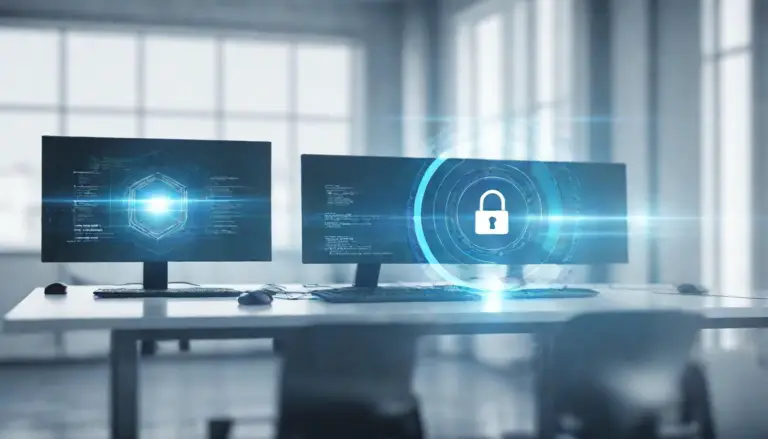Cyberattackers are getting more advanced and becoming more significant threats for businesses of all sizes. Cybersecurity is an essential topic for IT departments, but it should be a priority for your entire organization.
Cyber-attacks or cybersecurity breaches are incredibly costly for companies. Cyberattacks can compromise critical business data, resulting in downtime, expensive recovery efforts, and a lack of trust from customers.
To educate employees on cybersecurity and outline each person’s responsibilities, companies must develop a cybersecurity policy. Both office tech and the WFH environment pose severe cyber risks that a valid policy can help minimize.
Read on to learn about the top cybersecurity risks and how to mitigate them.
Cybersecurity Risks
Infrastructure Vulnerabilities
Both internal and external vulnerabilities pose cybersecurity risks. When companies fail to cover the cybersecurity basics, they leave themselves open to cybercriminals. Cyber attackers rely on less than 12 primary vulnerabilities to hack organizations because organizations are not covering these basic vulnerabilities. For example, most internal vulnerabilities are related to outdated patch levels. Additionally, relying solely on antivirus without encrypting data is a huge mistake many businesses make.
Human Error Leads to Greater Risk
Your infrastructure is essential, but many cybersecurity risks are via human behavior. For one, lower-level employees are more likely to become malicious insiders. It’s imperative to set and monitor their access levels carefully. However, many employee risks are unintentional. When employees are unaware of cybersecurity best practices, they may unknowingly do things (set weak passwords, fail to update software, etc.) to jeopardize your enterprise security.
Bring Your Own Device
Many companies allow employees to use their own devices in light of working from home and hybrid environments. Having a BYOD policy offers a flexible environment and better working conditions for many employees. However, this practice comes with cybersecurity risks that technical teams must carefully address. For example, one in five organizations has suffered a mobile security breach driven by malware and malicious WiFi. Mandatory password protection and protocol for lost/stolen devices are critical.
Unapproved Personal Applications
BYOD practices can also cause work life and personal life to overlap, especially when employees work from home. When workers use unapproved applications on work hardware (including social media and personal web browsing), it increases phishing and malware risk.
Lack of Cybersecurity Standards
Smart organizations have cybersecurity standards, but too many of them neglect to have a cybersecurity policy. Failing to prioritize cybersecurity will have your employees disengaged with the issue, and businesses cannot afford this. It’s crucial to identify your cybersecurity risks, create an oversight process, and protect your information with a cybersecurity policy.
No Recovery Plan
An enormous consequence of cybersecurity risks is downtime and data loss, which is why every organization must thoroughly plan for a cyber attack. Detail what could happen in the cyberattack and the steps you will take to minimize the damage. 77 percent of organizations lack a recovery plan. While you should dedicate most resources to prevention, recovery is also a crucial part of cybersecurity.
The Advancing Landscape of Cyber Attacks
Cybersecurity risks are so dangerous because they are constantly evolving. Current malware is capable of polymorphism, meaning it can change so frequently that anti-malware programs struggle to identify it. While your first line of defense should be a program to identify malware and patch vulnerabilities, but your second will need to be more extreme. As malware progresses, you may need to shut down network segments or remove specific devices from the network.
The Importance of a Cybersecurity Policy
The best way to mitigate cybersecurity risks and the potential impact of an attack is with a firm cybersecurity policy. A cybersecurity policy lays out the rules for employees and other end-users to access the work network, send data, use online applications, and practice responsible cybersecurity.
According to a McAfee report, people inside the organizations cause 43 percent of data loss, with half of this being accidental. A clear cybersecurity policy along with employee training can drastically reduce your cybersecurity vulnerability.
Cybersecurity Policy Checklist
Create a cybersecurity policy that addresses your needs. The length of your policy will depend on the size of your organization and your requirements. Focus on the areas of primary importance. Also, make sure that it’s easy for employees to read and understand.
- Roles and Responsibilities. The first section of the cybersecurity policy should lay out the security roles, responsibilities, and expectations within your company.
- Sections of areas of cybersecurity. For example, you should have sections about antivirus software, cloud applications, etc.
- Limit the use of personal email, document sharing, social media, etc.
- Email encryption. Email encryption should be standard practice for your organization, even for WFH employees.
- Encrypt devices at rest. To prevent data loss in the event of theft, encrypt all devices (including servers) at rest.
- Require secure passwords. All passwords and log-in information must be secure. Employees should carefully store the information in a trusted password manager application. For WFH employees, this practice should extend to their home WiFi password.
- BYOD policy. If you allow employees to use their own devices on the network, create a clear policy about this. Require a mobile device management system and strong password so that your technical teams can wipe the company data remotely if the device is lost or stolen.
Train Employees
Simply tossing a policy at your team is not going to be enough. Include training for your in-office and remote team. Include cybersecurity practices and cyberattack prevention in the training. Ensure that every employee understands the cyber threats, how to identify them, and how to respond. Some topics to include are:
- How to spot phishing emails
- How to work from home securely
- Preventing home vulnerabilities from affecting the office
The best training plans will include a test of the knowledge. Additionally, it would help if you revisited the topic to remind your team and address any new information for cybersecurity best practices.
Additional Tips for Securing the Home Office
Many companies also have remote employees and must uniquely consider the WFH environment. Cybersecurity policy practices should extend to the WFH environment, and companies must also consider additional risks. Some tips include:
- Employees must also have a strong home WiFi password.
- How can the IoT impact the security of sensitive information? Consider including rules about the proximity of always-listening devices (smart speakers and virtual assistant).
- Ensure your employees keep personal devices used for work updates. You could require employees to set the personal devices to update automatically.
- Training specified for remote work and cybersecurity considerations.
Consult a Technology Expert
Cybersecurity risks are only mounting for businesses of all kinds. Creating a safe cybersecurity environment requires a cybersecurity policy that also addresses remote work. IT leaders must consider the unique risks that remote work poses and educate employees on minimizing these risks.
For help addressing cybersecurity and creating a policy, consult a technology expert. The knowledgeable team at Teksetra offers business support to help you create a cyber-secure environment for your entire organization.



